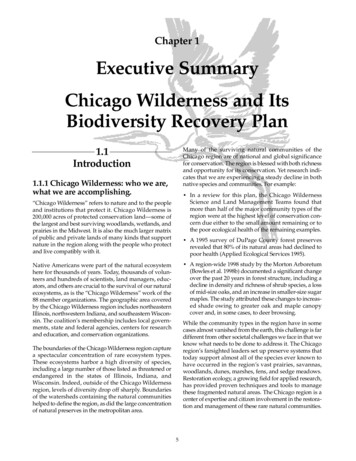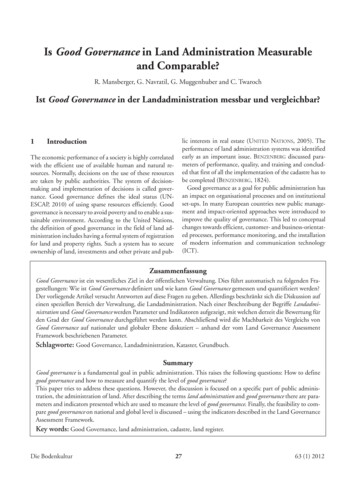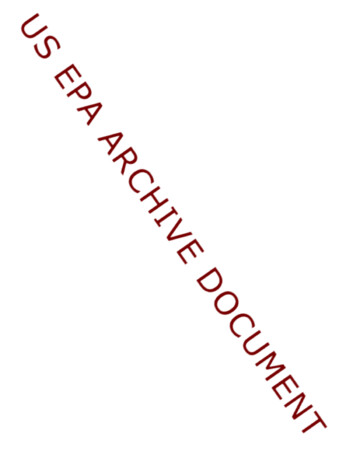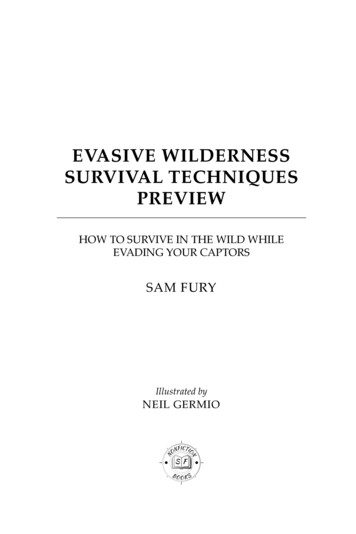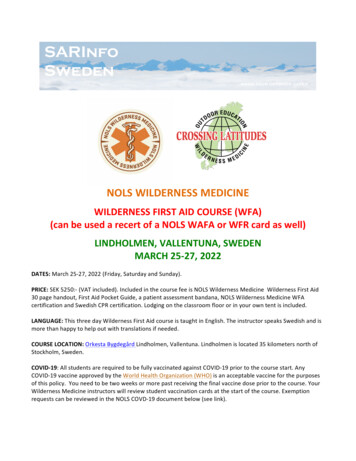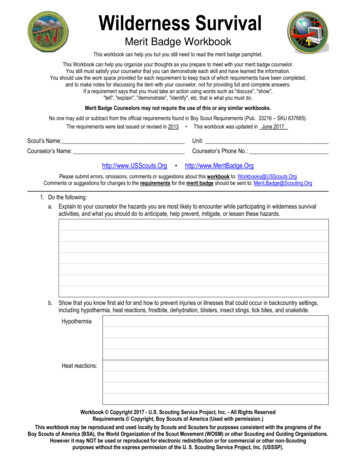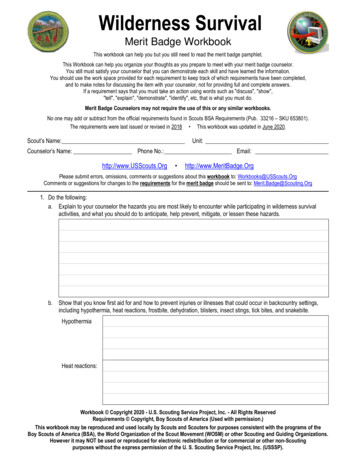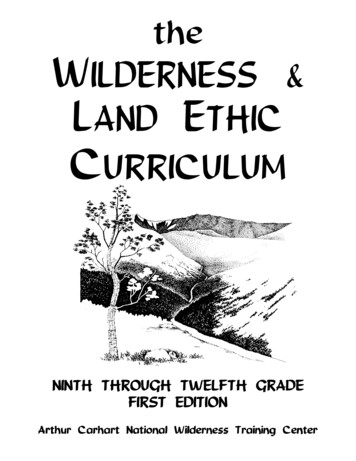
Transcription
theWILDERNESS &LAND ETHICCURRICULUMNINTH THROUGH TWELFTH GRADEFIRST EDITIONArthur Carhart National Wilderness Training Center
TABLE OF CONTENTSFOREWORD .iINTRODUCTION . iiWILDERNESS: AN OVERVIEW . . . . . . . . . . . . . . . . . . . . . . . . . . . . . . 1LEAVE NO TRACE FIELD EXPERIENCEE . . . . . . . . . . . . . . . . . . . . . . . . . . . . .31Lesson 1: The Best Trip is Well Planned!Activity 1: Are You Ready?Activity 2: Will You Make It?Activity 3: Developing a “Total Food Planning” ListActivity 4: The Skills TrailLesson 2: A Wilderness Backpacking TripActivity 1: Planning a Wilderness Backpacking TripActivity 2: Activities for a Backpacking TripLesson 3: Reflections on Wild Places-A Journal-Making ActivityActivity 1: Setting the StageActivity 2: Journaling Layers of the LandscapeSOCIAL STUDIESAmerican Government . . . . . . . . 75Lesson 1: Who Manages Wilderness?Activity 1: Legislation and ManagementAmerican Government; Geography . . . . . . . . . 79Lesson 2: National Wilderness Preservation System, Geographic LocationsActivity 1: National Wilderness Preservation System. 82Communication Arts: English; Speech/Debate . . . . .Lesson 3: Fact vs. OpinionActivity 1: Opposing ViewpointsActivity 2: We Can’t Always Believe What We Read!Lesson 4: Wilderness Issues: Community Attitude SurveyActivity 1: Wilderness Issues: Community Attitude SurveyCommunication Arts: English; Speech Debate; Stewardship . . . . . . . . . . . . . . . . . 97Lesson 5: Wilderness Management Case StudiesActivity 1: Wilderness Management ScenariosHistorical/Cultural Perspectives . . . . . . . 108Lesson 6: Celebrating Our Diversity Through WildernessActivity 1: Visions of the WildActivity 2: All Things are Connected
TABLE OF CONTENTSSOCIAL STUDIES (cont.)American Government/History Connections . . . . . . . . . . . . . . . . . . . . . . . . . . . . . . . . . . . . . . . . . . . . . . . . 111Lesson 7: The Wildlands Proposal - Mapping Out Future Living SpaceActivity 1: Mapping a Regional Wilderness Recovery Network for a Local AreaLesson 8: Wilderness: Human Uses, Past and PresentActivity 1: Wilderness: Human Uses, Past and PresentLesson 9: Recognizing Recreational Benefits of WildernessActivity 1: Wilderness Carrying CapacityActivity 2: Plan a TripActivity 3: Wilderness Value Questions to PonderActivity 4: Observing Ecological Processes on the LandscapeCareers Information for Counselors . . . . . . . . . . . . . . . . . . . . . . . . . . . . . . . . . . . . . . . . . . . . . . 129Lesson 10: Wilderness CareersActivity 1: Wilderness Career OpportunitiesActivity 2: Early Day RangersLeadership Skills . . . . . . . . . . . . . . . . . . . . . . . . . . . . . . . . . . . . . . . . . . . . . . . . . . . . . . . . . . . . . . . . . . . 137Lesson 11: Perspectives on LeadershipActivity 1: Qualities of an Outdoor LeaderActivity 2: Developing GOOD JudgementActivity 3: Leadership TraitsAmerican Government; CommunicationArts; Peer Tutoring . . . . . . . . . . . . . . . . . . . 146Lesson 12: Protecting Open SpaceActivity 1: Protecting Open for WildlifeLesson 13: Life-style and Wilderness (Issues & Action Practicum)Activity 1: Life-style and WildernessLesson 14: Teaching a Wilderness Lesson (Teaching Practicum)AMERICAN HISTORY American Government . . . . . . . . . . . . . . . . . . . . . . . . . . . . . . . . . . . . . . . . . . . . . . . . . . . . . . . . . . . . . . . . . . . . . . . . .Lesson 1: What is Wilderness?Activity 1: What is Wilderness?Activity 2: Citizen Action: the Wilderness ActLesson 2: Environmental Policy HistoryActivity 1: The American Experience: Battle for WildernessActivity 2: Muir and Pinchot TodayActivity 3: Wilderness Timeline176
TABLE OF CONTENTSAMERICAN HISTORYLesson 3: Historical PhotographsActivity 1: A Wild Image Frozen in TimeLesson 4: Traditional ToolsActivity 1: Traditional ToolsLesson 5: Minimum ToolsActivity 1: Minimum ToolsLesson 6: Wilderness LiteratureActivity 1: The Power of LiteraturePerspectives; Literature . . . . . . . . . . . . . . . . . . . . . . . . . . . . . . . . . . . . . . . . . . . . . . . . . . . . . . . . . . . . 215Lesson 7: Historical and Cultural Perceptions of WildernessActivity 1: A Letter too LateActivity 2: Interacting on the FrontierLesson 8: The Wilderness CommonsActivity 1: Tragedy of the CommonsActivity 2: The Place, the Region, and the CommonsActivity 3: The Commons DilemmaActivity 4: The Wilderness ExperienceCommunication Arts; Research . . . . . . . . . . . . . . . . . . . . . . . . . . . . . . . . . . . . . . . . . . . . . . . . . . . . 225Lesson 9: Wilderness Heroes & HeroinesActivity 1: Wilderness Heroes & HeroinesAmerican Government, Communication Arts, Speech/Debate Connections . . . . . . 233Lesson 10: Prohibitions and Conflicting Uses in WildernessActivity 1: Prohibitions and Conflicting Uses in WildernessActivity 2: Summing It All Up, What Do You Think?Activity 3: Mechanized Mountain BikingStewardship, Communication Arts, Speech/Debate . . . . . . . . . . . . . . . 243Lesson 11: Wilderness: A Way of LifeActivity 1: All things are ConnectedActivity 2: Native American StorytellingLesson 12: Looking Into the FutureActivity 1: Wilderness Management DilemmaENGLISHAmerican Government . . . . . . . . . . . . . . . . . . . . . . . . . . . . . . . . .Lesson 1: Rewriting the Wilderness ActActivity 1: Rewriting the Wilderness Act252
TABLE OF CONTENTSENGLISH (cont.)Literature: American History . . . . . . . . . . . . . . . . . . . . . . . . . . . . . . . . . . . . . . . . . . . . . . . . . . . . . . . . . . . . . . . . . . . . . . . . . . . . . . . . . . .Lesson 2: Wilderness LiteratureActivity 1: The Power of Literature259Activity 2: Freedom and WildernessActivity 3: The Etiquette of FreedomResearch . . . . . . . . . . . . . . . . . . . . . . . . . . . . . . . . . . . . . . . . . . . . . . . . . . . . . . . . . . . . . . . . . . . . . . . . . . . . . . . .Lesson 3: Contemporary Role Models in Wilderness & Land EthicsActivity 1: Contemporary Role Models in Wilderness & Land Ethics266Aesthetics; Creative Writing . . . . . . . . . . . . . . . . . . . . . . . . . . . . . . . . . . . . . . . . . . . . . . . . . . . . 270Lesson 4: Reflections on Wild Places - A Journal-Making ActivityActivity 1: Setting the StageActivity 2: Journaling - Layers of the LandscapeLiterature Perspectives . . . . . . . . . . . . . . . . . . . . . . . . . . . . . . . . . . . . . . . . . . . . . . . . . . . . . . . . . . . . . . . . . . . . . . . . . . . . . . . . . . . . . . . . . . .Lesson 5: Story: Communicating ExperienceActivity 1: Parts of a Story275Activity 2: Landscape and NarrativeLesson 6: Perceptions of the WildActivity 1: Perceptions of the WildLiterature Connections . . . . . . . . . . . . . . . . . . . . . . . . . . . . . . . . . . . . . . . . . . . . . . . . . . . . . . . . . . 283Lesson 7: Wilderness ConnectionsActivity 1: Connecting With WildernessT HE A RTSAesthetics/Visual Arts . . . . . . . . . . . . . . . . . . . . . . . . . . . . . . . . . . . . . . . . . . . . . . . . . . . . . . . . . . . . . . . . . . . . . . . . . . . . . . . . . . . . . . . . . . . . .Lesson 1: The Art of Wild PlacesActivity 1: The Art of Wild Places289Activity 2: Wilderness and the ImaginationDance/Movement/Music . . . . . . . . . . . . . . . . . . . . . . . . . . . . . . . . . . . . . . . . . . . . . . . . . . . . . . . . . . . . . . . . . . . . . . . . . . . . . . . . . . . . . . . . . .Lesson 2: Wilderness and Performing ArtsActivity 1: Story Without WordsActivity 2: Do You Hear What I Hear?Lesson 3: Spaces and Places: Human Environments and WildernessActivity 1: Aimless WanderingActivity 2: The GridActivity 3: Arcing292
TABLE OF CONTENTSTHE ARTS (cont.). . . . . . . . . . . . . . . . . . . . . . . . . . . . . . . . . . . . . . . . . . . . . . . . . . 304Visual Arts Perspectives .Lesson 4: Historical PhotographsActivity 1: A Wild Image Frozen in TimeLesson 5: Landscape Artists and PhotographersActivity 1: Landscape Artists and PhotographersLesson 6: PhotographyActivity 1: Photos Keep It Happening!Communication Arts; Media Literacy Connection. . . . . . . . . . . . . . . . . . . . . . . . . .Lesson 7: “Oooh You Wild Thang” - Wild Places Used in Making the PitchActivity 1: Advertisement CollectionActivity 2: Simulation DiscussionS CIENCEBiology . 323Lesson 1: Wilderness EcosystemsActivity 1: A Journey Through the National Wilderness Preservation SystemBiology; Research . . . . . . . . . . . . . . . . . . . . . . . . . . . . . . . . . . . . . . . . . . . . . . . . . . . . . . . . . . . . . . . . . . . . . . . . .Lesson 2: Wilderness ResearchActivity 1: Wilderness ResearchBiology Connections . . . . . . . . . . . . . . . . . . . . . . . . . . . . . . . . . . . . . . . . . . . . . . . . . . .Lesson 3: Noxious Weeds - What Can I Do?Activity 1: Who Lives Here?.327333Activity 2: Weed Management Field TripLesson 4: Endangered SpeciesActivity 1: Endangered SpeciesEcology; Earth Science; Geology . . . . . . . . . . . . . . . . . . . . . . . . . . . . . . . . . . . . . . . . . . . . . .Lesson 5: Geology: Shaping LandscapesActivity 1: Identifying LandformsActivity 2: Natural Landforms, What Relief!Activity 3: Branching out: Take a Look at LandformsActivity 4: Geology of Wild PlacesLesson 6: A Source of Fresh Water - Wilderness WatershedsActivity 1: Map Symbols BingoActivity 2: Reading the LandContours!Activity 3: Mapping a WatershedLesson 7: Air QualityActivity 1: Payne’s WorldActivity 2: Air Strips. . . . . . . . . . . . . . . . . . . . . . . . . . . . 353312
TABLE OF CONTENTSSCIENCE (cont.)Stewardship; Ecology; American Government . . . . . . . . . . . . . . . . . . . . . . . . . . . . . . . . . . . . . . . . . . . . . . . . . . . .Lesson 8: Connecting to Our Natural WorldActivity 1: Wildland Designation389Activity 2: Values and Benefits of WildernessActivity 3: Making the ConnectionM ATHGeography . . . . . . . . . . . . . . . . . . . . . . . . . . . . . . . . . . . . . . . . . . . . . . . . . . . . . . . . . . . . . . . . . . . . . . . . . . . . . . . . . . . . . . . . . . . . . . . . . . . . . . . . . . . . . . .Lesson 1: Wilderness Happenings - What the Numbers Tell UsActivity 1: Where is Wilderness405Activity 2: Growth of National Wilderness Preservation SystemActivity 3: AlaskaEcology; Biology . . . . . . . . . . . . . . . . . . . . . . . . . . . . . . . . . . . . . . . . . . . . . . . . . . . . . . . . . . . . . . . . . . . . . . . . . . . . . . . . . . . 416Lesson 2: Carrying Capacity: What is a Viable Population? A Lesson on Numbersand SpaceActivity 1: Do You Have Enough Space for Those Animals?Stewardship; Resource Conservation . . . . . . . . . . . . . . . . . . . . . . . . . . . . . . . . . . . . . . . . . . . . . . . . . . . . . . . . . . . . . . . . . .Lesson 3: Energy Consumption and WildernessActivity 1: Renewable Energy Research and Development422Activity 2: Flip the Switch for WildlifeREADINGS AND REFERENCES . . . . . . . . . . . . . . . . . . . . . . . . . . . . . . . . . .429GLOSSARY OF TERMS . . . . . . . . . . . . . . . . . . . . . . . . . . . . . . . . . . . . . . . . . . . . .435APPENDICES . . . . . . . . . . . . . . . . . . . . . . . . . . . . . . . . . . . . . . . . . . . . . . . . . . . . . . . . . . . . . . . . . .441
ForewordJudging by the inquiries we've received from teachers, wilderness managers, and the public, thearrival of this first edition of the Wilderness and Land Ethic Curriculum for grades 9 through 12 isnearly a blessed event, not just for us, but for the community that values wilderness. We recognizethat what you have before you has taken many months to appear, partly as a result of its complexity, and partly because of our desire to make it the best possible tool. Well, here you have it.If you find errors in the text, just let us know so we can fix them in subsequent versions. Likewise,we will be looking for better ways to get this curriculum into the hands that need it most. And remember, the most recent edition of this document will always be on the Web at www.wilderness.net.There are many, many selfless people who contributed to this finished product. Those that firstcome to mind are Chris Ryan (at the Carhart Center) who shepherded this curriculum through thelabyrinths of its creation; Kari Gunderson, who envisioned the final product and developed much ofthe content; and Pam Davis, curriculum development specialist, who helped make it a most compelling and functional document.Lessons were pilot tested by teachers in their classrooms, throughout the country, and their feedback is woven into nearly every page. Heartfelt thanks go to those many teachers. Several federalemployees acted as regional coordinators for pilot testing: Barb Miranda, Mark De Greggorio, AliceCohen, Marcia Heymen, Patrick Lancaster, Susan Sater, Greg Hansen, and Rol Hesselbart. Aftersuch a long wait for the final product, they will probably be relieved and even surprised to finally seethe fruit of their labor. Special thanks go to Laurie Kreis at the Carhart Center for help with textrevisions and pilot test distribution. Thanks as well to Dave Cornell, whose computer magic andquiet patience translated seemingly indecipherable margin notes into a coherent and legible product.Thanks should really go out in concentric circles, like spreading ripples on water, to more and morepeople who in some way contributed to this project. But this foreword is long enough, and I earnestly hope you all know who you are and can recognize and value your contributions. The German philosopher Goethe wrote that we are shaped and fashioned by what we love. You have allbeen shaped and fashioned by your passion for wilderness, and this curriculum you are holding inyour hands today has been shaped and fashioned by you as well. Thank you.Connie G. MyersDirectorArthur Carhart National Wilderness Training CenterMissoula, MontanaApril 1999i
IntroductionWELCOME TO THE 9TH THROUGH 12TH GRADE WILDERNESS CURRICULUM!The National Wilderness Preservation System, totaling approximately 104 million acres and consisting of 630 individual Wilderness units, is under the jurisdiction of four land management agencies:three in the Department of Interior and one in the Department of Agriculture. The National Wilderness Preservation System was established with the passage of the Wilderness Act in 1964. TheWilderness Act begins with these prophetic words:In order to assure that an increasing population, accompanied by an expanding settlement andgrowing mechanization, does not occupy and modify all areas of the United States. leaving nolands designated for preservation and protection in their natural condition, it is hereby declared tobe the policy of the Congress to secure for the American people of present and future generationsthe benefit of an enduring resource of wilderness.Wilderness or wilderness?In this curriculum we have used wilderness and Wilderness throughout the text. We have distinguished between the two by using wilderness to denote the concept of wilderness, wild lands, andwild places. When Wilderness is used, it refers to federal lands that have been protected under lawby Congress as designated Wilderness. These lands are included in the National WildernessPreservation System, managed by the Forest Service, National Park Service, Bureau of LandManagement, and the Fish and Wildlife Service.HOW THIS CURRICULUM IS ORGANIZEDThis Wilderness Curriculum is designed to provide classroom teachers, land managers and outdooreducators with an interactive resource to promote awareness and appreciation of the cultural,environmental, and experiential values of wilderness.This curriculum is divided into a Wilderness: An Overview section, a Leave No Trace/ Field Experience section, and then six subject matter sections: Social Studies, American History, English, TheArts, Science, and Math. We recommend that you first peruse Wilderness: An Overview for aconcise orientation to what wilderness is all about, then take a look at the array of lessons andactivities that pertain to your area of emphasis. Please keep in mind that lessons of interest to youmay be found under more than one subject area.Following the lessons and activities, you will find a glossary of terms, suggested background reading materials, and a listing of components that make up the complete 9th - 12th grade WildernessBox.The Wilderness Box is a collection of most of the materials you will need to carry out any of theactivities in this curriculum. The Box is an excellent resource for a school or school district,providing teachers of different subject areas easy access to the tools they need to teach thelessons. Materials included in the box are referenced by a Í. But please keep in mind thatyou do not have to have the Box to be able to utilize this curriculum. You should be able to easilyii
INTRODUCTIONobtain supporting materials for any of the activities locally; we have also included a list of vendors ofthe specific Box components at the end of this curriculum. We encourage you to adapt the lessonsto your own settings and needs.This curriculum is accompanied by The Wilderness Reader, which contains the texts of most of thereadings referred to in the lessons. The Reader can also stand alone as a delightful collection ofessays that will inspire you and deepen your understanding and appreciation of wilderness.PHILOSOPHY"In the endwe will conserve only what we love,we will love only what we understand,and we will understandonly what we are taught."-- Baba BioumWilderness is a teacher. Wilderness areas are living classrooms from which knowledge aboutourselves and our world are lessons, waiting to be learned. The best way to learn about wildernessis to go there. First-hand field experiences are exponentially more powerful than second-handclassroom experiences. Getting out of the boxed-in walls of a classroom into the three-dimensionalworld of wilderness will instill in students a desire to learn more about wilderness, making theclassroom lessons much more powerful. This will lead to an appreciation of wilderness and adesire to act as good stewards of our wilderness areas.For this reason, the field experience portion of the Wilderness and Land Ethic Curriculum precedesclassroom experiences. Every effort should be made to arrange field trips to places where studentscan see, hear, smell, taste, and feel the natural wonders of our world.NATIONAL SCIENCE EDUCATION STANDARDSThe National Science Education Standards were published in 1996 by the National ResearchCouncil. The National Science Teachers Association along with the National Academy of Sciencesand other groups support this document that was designed to enable all students in the nation toachieve the goal of becoming scientifically literate.Connections between the Standards and the Wilderness and Land Ethic Curriculum include:Identify and Use Resources Outside the School:"The school science program must extend beyond the walls of the school to the resources of thecommunity. The physical environment in and around the school can be used as a living laboratoryfor the study of natural phenomena."Connect to Other School Subjects:"Student achievement in science and in other school subjects such as social studies, language arts,and technology is enhanced by coordination between and among the science program and otherprograms. As an example, the National Standards for Geography include knowledge about landforms, as do the earth and space science standards. A combined geography and science unit isnatural."iii
INTRODUCTIONGood Science Programs Require Access to the World Beyond the Classroom:"District and school leaders must allocate financial support to provide opportunities for students toinvestigate the world outside the classroom. This may mean budgeting for trips to nearby points ofinterest such as a river, archaeological site, or nature preserve."Excerpted from: The National Science Education Standards, National Academy Press, 2101 Constitution Avenue, NW, Box 285, Washington, DC 20055; copyright 1996.NOW IT'S UP TO YOU!We've done our best to provide you with an interactive, compelling, and fun curriculum.The rest is up to you! We look forward to your feedback.Arthur Carhart National Wilderness Training Center20325 Remount Rd.Huson, MT 59846(406) 626-5208iv
WILDERNESS:AN OVERVIEW
TABLE OFCONTENTSFOREWORDINTRODUCTION
WILDERNESS: AN OVERVIEWWilderness: An Overview . 3Why Wilderness . 5Wilderness a Brief History . 9National Wilderness Preservation System . 12National Wilderness Preservation System Fact Sheet . 13Laws Affecting Wilderness Management. 14Land Classifications Related to Wilderness . 17Wilderness-Related Career Options . 19National Wilderness Preservation System Data . 20Wilderness Act. 461
WILDERNESS: AN OVERVIEWWILDERNESS: AN OVERVIEWThe most frequently asked questions about this thing called wilderness:What Is Wilderness?Wilderness is a place where the imprint of humans is substantially unnoticed. It is where naturalprocesses are the primary influences and human activity is limited to primitive recreation andminimum tools. This allows us to experience wild places without intention to disturb or destroynatural processes. Change will occur primarily through natural disturbance and minimum humaninfluence.Is It A Law?YES. In 1964 the Congress of the UnitedStates passed the Wilderness Act,restricting grazing, mining, timber cuttingand mechanized vehicles in these areas.They are protected and valued for theirecological, historical, scientific andexperiential resources. The law protectsthese values for future generations.Who Manages Wilderness?The National Wilderness PreservationSystem is managed by the National ParkService, Forest Service, Fish and WildlifeService and the Bureau of Land Management. Wilderness, designated by Congress, is one layer of protection, placedon top of original federal land designation.Although federal agencies are legallyresponsible for managing Wildernessareas, all citizens have a role and responsibility. As visitors, your behaviors and actions should beappropriate. As citizens, we should be aware of the impacts of our lifestyles on our country s wildlands.Why do we have to manage a Wilderness?Wilderness management is essentially the regulation of human use and influence in order topreserve the quality, character and integrity of these protected lands. We all must be aware of ourimpacts. As individuals our choices and consumption of resources may in some way degradewilderness values such as ecological health, solitude and aesthetics.We are managing for future generations, committing to having places that remain undisturbed forcenturies, not just decades. In order to keep Wilderness wild, we need to ensure that our socialand individual practices, both inside the Wilderness and outside, do not cause changes that willPage 3
WILDERNESS: AN OVERVIEWerode the resource.What are the threats to Wilderness?There are many issues in Wilderness. What is a minimum tool? What is primitive? What is Wilderness character and integrity? What is solitude? How do we manage threats, like air pollution,that are outside Wilderness? In many cases, societal pressures have the most significant effectupon wildland resources. Resource managers are discovering the significant connection betweensociety and Wilderness. For instance, pollution sources in cities can disturb plant and aquatic lifein seemingly distant and separate Wilderness lands.The ecological as well as recreational values of Wilderness must be maintained in preservingWilderness. With economic growth exerting pressures of a growing population, agencies areobserving many of these potential threats to the Wilderness resources including: Loss of character, quality and integrity of Wilderness; Loss of or threats to biological/ecological processesand biodiversity, through human disturbance; Soil compaction, vegetation loss or disturbance andreplacement by non-native species such as noxiousweeds, on trails and campsites caused by heavyrecreation use; Crowding, loss of solitude; Deterioration of water quality from improperdisposal of human waste and waste water; Air pollution from outside sources; Interruption of natural functioning ecosystems byfire suppression; Threats to native plant species from the spread ofnoxious weeds from sources outside Wilderness.So What Can I Do?Everyone has a role in protecting and managing Wilderness. Through your vote, your lifestyle andyour actions while visiting Wilderness, you can help reduce these threats to wild areas. Contactyour local Forest Service Ranger District, Park headquarters, BLM Resource Area or RefugeManager for more information.Page 4
WILDERNESS: AN OVERVIEWWHY WILDERNESS?Some thoughts about preservation.The preservation of wild lands is uniquely American. Our first contact with the new world exposed us to the rich culture of the American Indians and their intimate knowledge of thenatural world. Toward the end of the 19th century and the end of the frontier era, forwardlooking individuals such as John Wesley Powell, John Muir and Gifford Pinchot contributed to aconservation of public lands. They and others recognized that resources were limited andsettling the West, with an economic base of natural resources, required conservation practices.Arguments were made for the preservation of land for non-extractive purposes, and laws werepassed that today leave us with a precious treasure of undisturbed wild lands.Through recent history, Western European cultures and traditions have maintained a distinctseparation between the land and our human existence. Many people are beginning to see theconnections, beginning to see that we cannot separate ourselves from the land. Humans are apart of the natural world, not apart from it, and our style of living has effects upon the health ofthe bigger global environment.The preservation of wild lands has many values. Recognizing these diverse and unique valuesopens a world of understanding about the natural world. Preserving Wilderness may someday beseen through eyes of historians as the most important contribution societies can make to thehealth of the global environment. Here are some of those values.Together, they show how rare and valuable our wild lands are.Reservoirs of Biological Diversity The outstanding scientific discovery of the twentieth centuryis not the television, or radio, but rather the complexity of theland organism. Only those who know the most about it canappreciate how little is known about it. Aldo Leopold, A Sand County Almanac (1949)Wilderness is one part of the land organism . Wilderness plays a significant role in the overall healthof ecosystems. Rare and endangered plant and animal species require habitats that are relativelyundisturbed so gene pools can be sustained, adaptations made, and populations maintained. Manyrare and endangered species are indicators of ecological health, or they may play key roles in thebalance of the ecosystem. Natural disturbance, like floods or fires, maintain natural processes,systems, and patterns. Few places are left where rivers flood and trees are allowed to burn in naturalcycles. Wildness is the heart of the land organism .Page 5
WILDERNESS: AN OVERVIEWScientific ValueWilderness serves as a unique and irreplaceable living laboratory for medicinal and scientific research. Wilderness also protects geologic resources. Undisturbed, naturally occurring geologic phenomena are protected for present and future generations so they maypursue the origin of this planet and the universe.WatershedsMany Wildernesses are the headwaters of our rivers and water systems.These watersheds provide sources of clean water. Minimal human activityor development in these areas preserves waters for future generations.Without clean water, societies cannot flourish. The connection between ourWildernesses and our cities is most evident with water, our basic resource.Life Support SystemsWilderness serves as critical habitat for animal and plant life. Wilderness maintains genepools to provide diversity of plants and animal life. Today, as we learn more about the greenhouse effect and the depletion of the ozone layer, more and more people realize that humanityis part of an interconnected web of life, and that the survival of our own species may ultimately depend on the survival of natural areas.Page 6
WILDERNESS: AN OVERVIEWHistoric and Cultural ValuesWilderness is a unique repository for cultural resource.Artifacts and structures protected by the ArcheologicalResources Protection Act or other laws take on a newperspective when experienced within the context of theWilderness. These features tell a valuable story about thehuman relationship with wildlands.In addition, culture
Activity 1: Mapping a Regional Wilderness Recovery Network for a Local Area Lesson 8: Wilderness: Human Uses, Past and Present . Arthur Carhart National Wilderness Training Center Missoula, Montana April 1999 i. Introduction WELCOME TO THE 9TH THROUGH 12TH GRADE WILDERNESS CURRICULUM!


